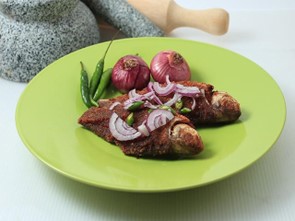ARTS AND CULTURE INFORMATION GATEWAY
Immerse yourself in the colorful world of art and culture! From traditional heritage to contemporary works, discover uniqueness that reflects the nation's identity and identity
PEKASAM
Picture
1
Video
No record
Today's Visitor
4
Number of Visitors
34
Introduction and history
Pekasam is one of the traditional foods well-known in the state of Kedah, which has become a part of the culinary heritage of the Malay community in northern Peninsular Malaysia.
"Ikan pekasam" is another name for fermented fish that has been preserved with salt and toasted rice. Freshwater fish such as sepat, lampam, and puyu are commonly chosen to make ikan pekasam. Freshwater fish are preferred because their scales are more abundant compared to saltwater fish. This is because saltwater fish, which have fewer scales, are less able to absorb the flavor of the toasted rice, making them less suitable for producing ikan pekasam.
This preservation process allows the fish to be stored for a longer period while also enhancing its unique and delicious flavor. This dish is often served as a side dish or accompaniment to rice and is highly favored for its salty, spiced, and slightly tangy taste resulting from the fermentation process.
-
The main ingredient in making pekasam is fish, typically freshwater fish such as sepat or lampam. These fish are thoroughly cleaned and marinated with key ingredients such as salt, toasted rice (used to create a powder that is mixed with other ingredients), as well as lemongrass and spices like galangal, ginger, and garlic. This salting and marination process is carried out over several days to ensure the fish absorbs the spices and achieves a longer shelf life.
The preparation process for pekasam is as follows:
1. Wash the fish thoroughly to remove any impurities.
2. Soak the fish with toasted rice that has been crushed and mixed with salt.
3. After that, arrange the fish mixed with these ingredients in a container and leave it for several days to ferment. This fermentation process is important to give the pekasam its authentic taste, where the fish develops a distinctive aroma that is the hallmark of pekasam.
4. After a few days, the pekasam is ready to be cooked either by frying or cooking it with sambal, making it a dish highly favored by the people of Kedah.
-
Reference Source
i. Bahan Bacaan
Handbook of Animal-Based Fermented Food and Beverage Technology. (2016). United States: CRC Press.
Ismail, N. I. (2022). Ikan pekasam sebagai makanan tradisional masyarakat Melayu di Kuala Nerang, Kedah [Tesis Sarjana Muda, Universiti Malaysia Kelantan]. Universiti Malaysia Kelantan Repository.
Location
State JKKN Contact Information
Encik Mohammad Salleh bin Mahmud
Cultural Officer
Jabatan Kebudayaan dan Kesenian Negara, Kedah
Kompleks JKKN Kedah
Lot PTD 400, Pumpong
05250 Alor Setar
KEDAH DARUL AMAN
011-10899646
Use the form below to contact the Informant/Figure/Editor/Researcher directly. We will respond to your inquiry as soon as possible!

 No 26, Jalan Ros, Felda Bukit Batu, 81020, Kulai, Johor
No 26, Jalan Ros, Felda Bukit Batu, 81020, Kulai, Johor







